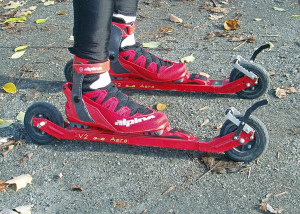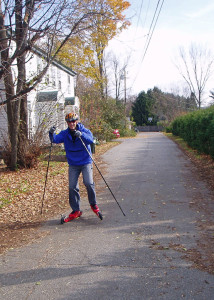
Unreliable winters sometimes frustrate avid fans of Nordic skiing here in the northeast. Some years, we never get any real snow until well into the new year. If you’re like me, you want your X-C season to start, oh, right about the end of October, and last at least into April, if not May.
Some recent Novembers and Decembers have left cross-country skiers feeling like second-class citizens. Alpine ski resorts have snowmaking to cover the slopes; most Nordic areas don’t.
Take heart, oh fellow X-C Ski Buffs! You can now ease your way into winter on the newest generation of roller skis, strengthening all the muscles you use to ski and polishing your technique at the same time.
Roller skis are nothing new. You’ve probably seen skiers out on the smooth shoulders of busy highways kicking and gliding or skating and poling along.
I’d tried it. Didn’t like it. The tiny wheels on most roller skis didn’t do very well on the rough roads of New England and northern New York. As with rollerblades, at any moment you could (or at least feel you could) be stopped by a random road crack and pitched headlong onto the pavement. Not a good feeling, especially if you want to relax and concentrate on your technique.

Still, I thought, good roller skis would be the final piece of the puzzle that would let you have fun and stay fit all year round. In the winter, you could cross-country ski if there was snow, or Nordic skate if there was ice. The rest of the time, you could just roll along . . .
Jamie Hess, who has built a thriving business called Nordic Skater in Norwich, VT first clued me in that roller skis have finally evolved into a form that works easily, comfortably and safely on the rough back roads and even dirt roads of our region.
He took me out on the latest generation of highly engineered roller skis, made in Milford, New Hampshire. The V2 Aero 125 Skate Roller Ski made by Jenex were almost everything I’d ever dreamed of. They also have versions to mimic “classic” kick-and-glide skiing if that’s your preference.

The V2 Aeros have big (five- or six-inch diameter) wheels that roll easily over any road roughness, with inflated tires that provide cushioning for a smooth ride. They also have easy-to-use, multi-position, lever speed governors which allow you to stay in perfect control down hills. They can even be fitted with training wheels and an emergency brake.
When I say they were almost perfect, the only flaw I can think of is the price—they retail for about $400 a pair with speed controls and bindings installed. Actually that’s not a bad price for something this highly engineered that you can use almost year ‘round.
Like any other form of skating, roller skiing takes some getting used to. I’d highly recommend wearing a helmet, gloves and the elbow and knee pads used by skateboarders. Hitting the pavement or the gravel is not something you want to do unprotected.
But once you get moving, the sensation is almost exactly the same as using skate skis on slightly crusty snow, or Nordic skates on slightly bumpy ice. You just glide along with your legs and poles providing the impetus. Actually, the speed governors make this even easier than skate skiing since it is easier to control your speed down hills. If you start to go too fast, you just bend down and click the brakes up an notch and you instantly slow down. Way cool design!
If you’d like to try this for yourself, Nordic Skater will let you try them for FREE out of their shop in Norwich, Vermont, or you can rent them for a nominal fee (he’ll even ship them to you) to get yourself ready for snow and ice season.
One warning: roller skiing along a quiet back road in late fall is almost as much fun as cross-country skiing. Once you try it, you’re gonna want to own a pair. I’ve already got ‘em on my list for Santa.
Life isn’t a spectator sport. Get out and enjoy!
Ice Awaits, Too
Roller skiing lit my fire not only for getting out on snow, but also for getting back on Nordic skates. Very often, there’s ice available on shallow, sheltered ponds long before any snow falls. And, because ponds and lakes all freeze at different rates, you can almost always find someplace where the ice formed in the deep cold and quiet after a major snowfall.
If you haven’t tried Nordic skating, you should. The skate-ski boots are warmer and provide lots more ankle support than figure skates or hockey skates, and the long blades float easily over rough natural ice.



Roller skiing…Could be fun, could help quell the “…I love Nashville but miss skiing” ouch, and address the need for aerobic issue
Questions
1) How impactful/not impactful will this be on the back. I am interested in both classic and skate. I assume skate is better for the heart, but what about the back?
2) Should I put the whole thing and just take up roller skating/roller blading?
3) Equipment. Sounds like boots are the most important thing…can one pair work for skate and classic?
4) Brakes?
Henry,
Thanks for writing! I’m no expert on roller skiing, so I’m going to turn you over to Jamie Hess (jamie@nordicskater.com) who knows what he’s talking about (and who sells and rents rollerskiing packages so you can try it out. )
I can tell you that its a lot of fun and great exercise. Didn’t bother my back at all, but I’m not usually bothered by much . . . Sounds like the perfect solution for the Nashville Blues . . .
Have fun.
Tim